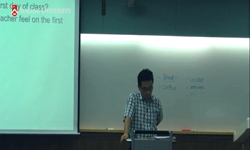The purpose of this study is to analyze the use of 'i/ga' and 'eun/neun' post position markers/particles by learners of Korean as a foreign language who consistently encounter errors despite increased language proficiency. In this study, the following...
http://chineseinput.net/에서 pinyin(병음)방식으로 중국어를 변환할 수 있습니다.
변환된 중국어를 복사하여 사용하시면 됩니다.
- 中文 을 입력하시려면 zhongwen을 입력하시고 space를누르시면됩니다.
- 北京 을 입력하시려면 beijing을 입력하시고 space를 누르시면 됩니다.
한국어 학습자의 '이/가', '은/는' 사용에 관한 연구 = A study on the KSL learners’use of '이/가(i/ga)' and '은/는(eun/neun)'
한글로보기https://www.riss.kr/link?id=T15071591
- 저자
-
발행사항
경산 : 영남대학교 대학원, 2019
-
학위논문사항
학위논문(석사) -- 영남대학교 대학원 , 외국어로서의한국어교육학과 외국어로서의한국어교육학전공 , 2019.2
-
발행연도
2019
-
작성언어
한국어
- 주제어
-
KDC
050 판사항(6)
-
발행국(도시)
경상북도
-
형태사항
iv, 107 p. : 삽화, 도표 ; 26 cm
-
일반주기명
지도교수: 최동주
영남대학교 논문은 저작권에 의해 보호받습니다 -
UCI식별코드
I804:47017-200000181797
- 소장기관
-
0
상세조회 -
0
다운로드
부가정보
다국어 초록 (Multilingual Abstract)
First, when summing up the test results, the rate of accuracy for ‘i/ga' was higher than that of 'eun/neun'; and the usage ‘eun/neun’ was the most frequent in sentences that function as an explanation of a topic and was the least frequent in terms of contrasting different categories. Second, in contrast to the test results, the rate of accuracy in written essays for ‘eun/neun’ was noticeably higher that of ‘i/ga' in the study. Third, the use ‘i/ga' and ‘eun/neun’ by the degree of mastery of the language of the learners, from all levels of learners, showed a lower rate of ‘eun/neun’ accuracy in the revision and confirmation of textual meaning than in the introduction of contrast indicators. It is understood that this is because learners tend to combine ‘eun/neun’ with sentences that explain the topic resulting in ‘eun/neun’ appearing to have a lower rate of accuracy for sentences that had contrasting meanings than for general topics. Fourth, intermediate-level learners were particularly error-prone in using 'i/ga' combined with ‘eun/neun’ and ‘eun/neun’ to correct and confirm their statements. As the learning progresses, it appears that the Korean research system is experiencing U-shaped development that occurs when learning a second language or a foreign language in the course of restructuring the Korean partical system. Fifth, through individual learner interviews, learners communicated their difficulty in the rate of accuracy of ‘i/ga' and 'eun/neun' in the context of communication resulting in a number of students simply not using 'eun/eun' rather than 'i/ga' in general, depending on their own assumptions.
Given that the ‘i/ga' and 'eun/neun' errors do not improve continuously despite numerous studies, it is necessary to take a more practical approach to this topic from the perspective of Korean language education. Therefore, it is suggested that teachers of Korean learners explicitly explain ‘i/ga' and 'eun/neun' to clarify the function of sentences that were the basis for their analysis.
The purpose of this study is to analyze the use of 'i/ga' and 'eun/neun' post position markers/particles by learners of Korean as a foreign language who consistently encounter errors despite increased language proficiency. In this study, the following four categories of pragmatical functions in sentences were categorized within the discourse: 1) The introduction of new indicators and the presentation/report of events; 2) sentences using 'i/ga' and 'eun/neun' to correct and confirm the introduction of the new indicator; 3) the statement that includes the primary meaning of the topic; and 4) the contrast of meaning in a sentence. Based on these four categories, test results and essays for Korean foreign language learners were analyzed and additional learner perceptions and strategies on the focal material were gathered through qualitative interview analysis. The following is a summary of the findings in this study.
First, when summing up the test results, the rate of accuracy for ‘i/ga' was higher than that of 'eun/neun'; and the usage ‘eun/neun’ was the most frequent in sentences that function as an explanation of a topic and was the least frequent in terms of contrasting different categories. Second, in contrast to the test results, the rate of accuracy in written essays for ‘eun/neun’ was noticeably higher that of ‘i/ga' in the study. Third, the use ‘i/ga' and ‘eun/neun’ by the degree of mastery of the language of the learners, from all levels of learners, showed a lower rate of ‘eun/neun’ accuracy in the revision and confirmation of textual meaning than in the introduction of contrast indicators. It is understood that this is because learners tend to combine ‘eun/neun’ with sentences that explain the topic resulting in ‘eun/neun’ appearing to have a lower rate of accuracy for sentences that had contrasting meanings than for general topics. Fourth, intermediate-level learners were particularly error-prone in using 'i/ga' combined with ‘eun/neun’ and ‘eun/neun’ to correct and confirm their statements. As the learning progresses, it appears that the Korean research system is experiencing U-shaped development that occurs when learning a second language or a foreign language in the course of restructuring the Korean partical system. Fifth, through individual learner interviews, learners communicated their difficulty in the rate of accuracy of ‘i/ga' and 'eun/neun' in the context of communication resulting in a number of students simply not using 'eun/eun' rather than 'i/ga' in general, depending on their own assumptions.
Given that the ‘i/ga' and 'eun/neun' errors do not improve continuously despite numerous studies, it is necessary to take a more practical approach to this topic from the perspective of Korean language education. Therefore, it is suggested that teachers of Korean learners explicitly explain ‘i/ga' and 'eun/neun' to clarify the function of sentences that were the basis for their analysis.
국문 초록 (Abstract)
첫째, 테스트 결과를 종합해 보면 테스트에서는 ‘이/가’의 정답률이 ‘은/는’의 정답률보다 더 높았고, 문장의 화용적 기능 가운데 ‘화제에 대한 설명’의 기능을 가진 문장에서 ‘은/는’의 정답률이 가장 높았고 ‘대조의 의미를 가지는 문장’에서 ‘은/는’의 정답률이 가장 낮았다.
둘째, 테스트와 달리 학습자들의 작문에서는 ‘대조의 의미를 가지는 문장’에서 정확도가 눈에 띄게 높아졌는데, 이 영향으로 작문 자료에서 ‘은/는’의 정확도가 ‘이/가’보다 더 높았다. 학습자들은 테스트에서 담화 맥락을 통해 대조의 의미를 파악해야 하는 경우, 이것을 대조의 상황으로 인식하지 못해 정답률이 낮았으나 자신이 대조의 의도를 가지고 주도적으로 사용하는 것에서는 테스트에서보다 더 정확하게 사용하고 있었다.
셋째, 두 조사의 사용을 학습자의 언어 숙달도별로 살펴보면, 초급학습자부터 중・고급학습자들까지 모두 ‘이/가’가 사용된 문장의 화용적 기능 가운데 지시체 도입·사건 제시/보고문의 경우보다 수정문·확인문에서 정답률이 더 낮게 나타났다. 이것은 학습자들이 수정문·확인문을 화제에 대해 설명하는 문장으로 보고 ‘은/는’을 결합시키는 경향이 있기 때문인 것으로 파악된다. ‘은/는’은 일반적인 화제에 대한 설명보다 대조의 의미를 가지는 문장의 경우 정답률이 더 낮게 나타났다. 학습자들은 대조의 의미를 가지는 문장을 ‘초점’이나 ‘특별히 지정’의 의미로 받아들여 ‘은/는’의 위치에 ‘이/가’를 결합시키는 경향이 있었는데 이것이 그 원인으로 보인다.
넷째, 중급학습자들의 경우, 수정문·확인문에서 ‘이/가’의 사용과 대조의 의미를 가지는 화제에 ‘은/는’을 결합하여 사용하는 것에서 특히 오류가 많았으며, 이 항목들에서 초급학습자들보다 더 낮은 정답률을 보였다. 학습이 심화되어 감에 따라 한국어 조사 체계에 대한 재구조화 과정에서 제 2언어 또는 외국어를 학습할 때 나타나는 U자형 발달을 경험하고 있는 것으로 보인다.
다섯째, 학습자 개별 인터뷰를 통하여, 학습자들은 ‘의사소통 상황에서 ’이/가’와 ‘은/는’의 선택이 어려운 경우, 많은 학생들이 조사를 생략해 버리거나 자신의 추측에 의지한 채 느낌대로 사용하며 일반적으로 ‘이/가’보다는 ‘은/는’을 선택하는 전략을 사용하는 것을 알 수 있었다.
그동안 수많은 연구에도 불구하고 ‘이/가’와 ‘은/는’의 오류가 지속으로 발생되는 현상이 개선되지 않음을 볼 때, 이 항목에 대해 한국어 교육의 관점에서 더 실용적인 접근을 시도할 필요성을 느낀다. 그래서 나는 한국어 학습자에게 ‘이/가’와 ‘은/는’을 명시적으로 설명할 것을 제안하며 본 연구에서 분석의 기준으로 삼았던 문장의 화용적 기능의 측면에서 접근하는 것이 학습자들의 명확한 이해에 도움이 된다고 본다.
본 연구는 언어 숙달도가 높아짐에도 불구하고 지속적으로 오류가 발견되는 한국어 학습자의 ‘이/가’와 ‘은/는’의 사용을 문장의 화용적 기능에 따라 분석하는데 그 목적이 있다. 이 연...
본 연구는 언어 숙달도가 높아짐에도 불구하고 지속적으로 오류가 발견되는 한국어 학습자의 ‘이/가’와 ‘은/는’의 사용을 문장의 화용적 기능에 따라 분석하는데 그 목적이 있다. 이 연구에서는 담화 내에서 문장의 화용적 기능을 4가지로 분류하였다. 먼저 ‘이/가’를 사용하는 문장은 첫째, 새로운 지시체의 도입과 사건 제시/보고문, 둘째, 수정하여 말하기와 확인하기, ‘은/는’을 사용하는 문장은 첫째, 화제에 대한 설명, 둘째, 대조의 의미를 가지는 문장이 그것이다. 이 네 가지의 항목을 기준으로, 한국어 학습자를 대상으로 한 테스트 결과와 학습자들의 작문을 분석하고 학습자 면담을 통하여 학습자들의 인식 양상과 사용 전략을 알아보았다. 이 연구에서 밝혀진 바를 정리해 보면 다음과 같다.
첫째, 테스트 결과를 종합해 보면 테스트에서는 ‘이/가’의 정답률이 ‘은/는’의 정답률보다 더 높았고, 문장의 화용적 기능 가운데 ‘화제에 대한 설명’의 기능을 가진 문장에서 ‘은/는’의 정답률이 가장 높았고 ‘대조의 의미를 가지는 문장’에서 ‘은/는’의 정답률이 가장 낮았다.
둘째, 테스트와 달리 학습자들의 작문에서는 ‘대조의 의미를 가지는 문장’에서 정확도가 눈에 띄게 높아졌는데, 이 영향으로 작문 자료에서 ‘은/는’의 정확도가 ‘이/가’보다 더 높았다. 학습자들은 테스트에서 담화 맥락을 통해 대조의 의미를 파악해야 하는 경우, 이것을 대조의 상황으로 인식하지 못해 정답률이 낮았으나 자신이 대조의 의도를 가지고 주도적으로 사용하는 것에서는 테스트에서보다 더 정확하게 사용하고 있었다.
셋째, 두 조사의 사용을 학습자의 언어 숙달도별로 살펴보면, 초급학습자부터 중・고급학습자들까지 모두 ‘이/가’가 사용된 문장의 화용적 기능 가운데 지시체 도입·사건 제시/보고문의 경우보다 수정문·확인문에서 정답률이 더 낮게 나타났다. 이것은 학습자들이 수정문·확인문을 화제에 대해 설명하는 문장으로 보고 ‘은/는’을 결합시키는 경향이 있기 때문인 것으로 파악된다. ‘은/는’은 일반적인 화제에 대한 설명보다 대조의 의미를 가지는 문장의 경우 정답률이 더 낮게 나타났다. 학습자들은 대조의 의미를 가지는 문장을 ‘초점’이나 ‘특별히 지정’의 의미로 받아들여 ‘은/는’의 위치에 ‘이/가’를 결합시키는 경향이 있었는데 이것이 그 원인으로 보인다.
넷째, 중급학습자들의 경우, 수정문·확인문에서 ‘이/가’의 사용과 대조의 의미를 가지는 화제에 ‘은/는’을 결합하여 사용하는 것에서 특히 오류가 많았으며, 이 항목들에서 초급학습자들보다 더 낮은 정답률을 보였다. 학습이 심화되어 감에 따라 한국어 조사 체계에 대한 재구조화 과정에서 제 2언어 또는 외국어를 학습할 때 나타나는 U자형 발달을 경험하고 있는 것으로 보인다.
다섯째, 학습자 개별 인터뷰를 통하여, 학습자들은 ‘의사소통 상황에서 ’이/가’와 ‘은/는’의 선택이 어려운 경우, 많은 학생들이 조사를 생략해 버리거나 자신의 추측에 의지한 채 느낌대로 사용하며 일반적으로 ‘이/가’보다는 ‘은/는’을 선택하는 전략을 사용하는 것을 알 수 있었다.
그동안 수많은 연구에도 불구하고 ‘이/가’와 ‘은/는’의 오류가 지속으로 발생되는 현상이 개선되지 않음을 볼 때, 이 항목에 대해 한국어 교육의 관점에서 더 실용적인 접근을 시도할 필요성을 느낀다. 그래서 나는 한국어 학습자에게 ‘이/가’와 ‘은/는’을 명시적으로 설명할 것을 제안하며 본 연구에서 분석의 기준으로 삼았던 문장의 화용적 기능의 측면에서 접근하는 것이 학습자들의 명확한 이해에 도움이 된다고 본다.
목차 (Table of Contents)
- Ⅰ. 서론 1
- 1. 연구 목적 및 필요성 1
- 2. 선행 연구 3
- 2.1. 국어학 영역 3
- 2.2. 한국어교육학 영역 8
- Ⅰ. 서론 1
- 1. 연구 목적 및 필요성 1
- 2. 선행 연구 3
- 2.1. 국어학 영역 3
- 2.2. 한국어교육학 영역 8
- 3. 연구 대상 및 방법 13
- 3.1. 연구 대상 13
- 3.2. 연구 방법 13
- Ⅱ. ‘이/가’와 ‘은/는’의 의미 기능 21
- 1. ‘이/가’의 의미 기능 22
- 1.1. 지시체 도입 및 사건 제시/보고 22
- 1.2. 확인문 및 수정하여 말하기 27
- 2. ‘은/는’의 의미 기능. 29
- 2.1. 화제에 대한 설명 29
- 2.2. 대조 33
- Ⅲ. 한국어 학습자의 ‘이/가’, ‘은/는’ 사용 양상 37
- 1. 완성형 테스트를 통한 분석 37
- 1.1. ‘이/가’의 사용 37
- 1.1.1. 지시체 도입 및 사건 제시/보고 39
- 1.1.2. 수정문 및 확인문 39
- 1.2. ‘은/는’의 사용 40
- 1.2.1. 화제에 대한 설명 42
- 1.2.2. 대조 43
- 2. 선택형 테스트를 통한 분석 44
- 2.1. ‘이/가’의 사용 44
- 2.1.1. 지시체 도입 및 사건 제시/보고 45
- 2.1.2. 수정문 및 확인문 46
- 2.2. ‘은/는’의 사용 48
- 2.2.1. 화제에 대한 설명 49
- 2.2.2. 대조 50
- 3. 학습자 쓰기 자료를 통한 분석 51
- 3.1. ‘이/가’의 사용 52
- 3.1.1. 지시체 도입 및 사건 제시/보고 55
- 3.1.2. 수정문 및 확인문 56
- 3.2. ‘은/는’의 사용 57
- 3.2.1. 화제에 대한 설명 58
- 3.2.2. 대조 60
- 4. 테스트와 쓰기 자료의 비교 분석 63
- 4.1. 테스트를 통한 사용 양상 정리 63
- 4.2. 테스트와 쓰기 자료의 비교 69
- 5. 사후 인터뷰를 통한 분석 73
- 5.1. 인터뷰의 구성 73
- 5.2. 인터뷰 결과 분석 73
- Ⅳ. 결론 및 제언 82
- * 참고문헌 87
- * 부록 90
- 부록1. 검사지(학습자 테스트) 90
- 부록2. 사후 인터뷰 94
- 부록3. 한국인 모어 화자 직관 검사 결과 95
- * Abstract 105












